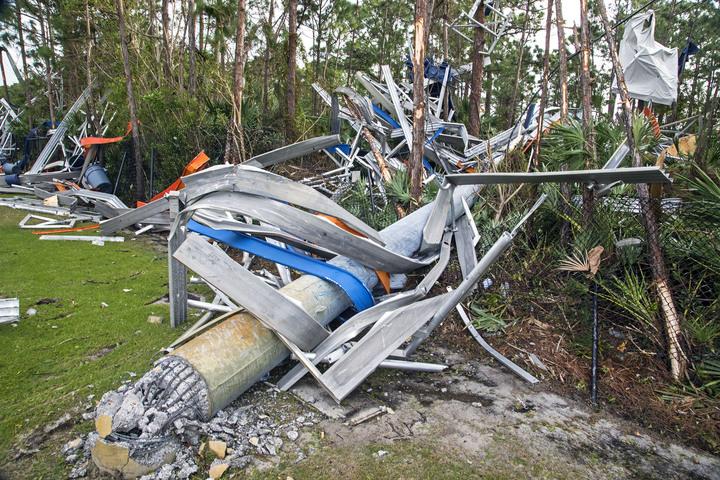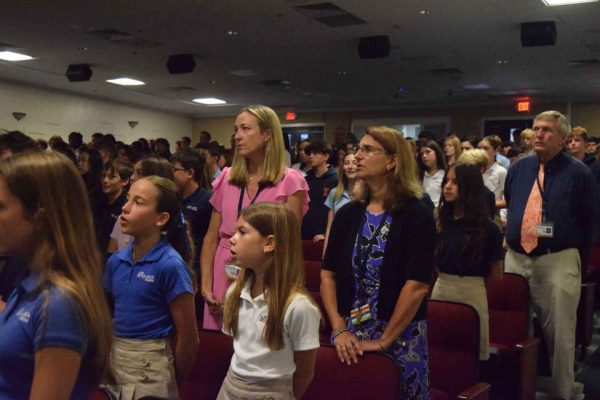Tornado Tears Through Upper School
Weather is unpredictable, as evidenced by the tornado that touched down at the Upper School Campus on January 23, 2017.
Photo courtesy of The Palm Beach Post (Lannis Waters)
A light pole lays toppled atop the twisted remains of the bleachers at the Upper School.
When people decide to pick a new place to live, what motivates their choices? Some people are motivated by the weather, a new job, moving closer to family, etc. Between 2012 and 2013, about 36 million Americans moved to a new home. That’s about one in every 8.5 people. According to a report from the U.S. Census Bureau, almost half of movers said quality of life was the reason they relocated. People wanted better neighborhoods and better homes, or they wanted to own rather than rent.
So how many people move to Florida each year? In 2015, the Sunshine State had the highest migration rate and the population topped out at 20 million people total. It’s understandable because of the climate and the ocean, but living in Florida has some downsides, too, and some of them can be downright deadly.
In fact, on January 23, a tornado hit The Benjamin Upper School, and destroyed both sets of the football bleachers, the track field, and the tennis courts. As a result, the Upper School Campus closed the following day as it was deemed unsafe for students and faculty.
“We canceled school on Monday as a result of all of the tree limb damage in the parking lot and in the entrance to the parking lot,” said Upper School Head Mr. Fletcher Carr. “There were also wires down on Central Avenue and an exploding transformer on the back edge of the Upper School property, so it simply did not appear possible for us to safely start school just hours later.”
Although the wreckage is in the process of being cleared, the Upper School still has a ways to go. “Ultimately, our goal is to rebuild the facility to a level that represents the best and safest standards moving forward,” said Carr.
Last year the Lower/Middle School Campus was under a tornado watch, but, thankfully, nothing happened. “It was really scary,” recalled seventh grader Tate Ford. “Our whole class thought it was a drill the first time we heard there was a tornado watch, but it wasn’t. I wasn’t really that worried because I knew we were protected, but I was still a little nervous.”
Hurricanes are also a constant threat in Florida, and with global warming on the rise, there may only be more of them. Warmer temperatures caused by the greenhouse effect cause glaciers to melt, increasing the amount of water in the ocean. Warmer water means more hurricanes because in order for a hurricane to form, two things must be present: a weather disturbance, such as a thunderstorm, that pulls in warm surface air from all directions, and water at the ocean’s surface that is at least 80° Fahrenheit (27° Celsius). Hurricanes also require warm water for them to spin. Typically, hurricane season stretches from June 1 to November 30 each year.
Hurricane Matthew back in October of 2016 caused some damage to the Middle School and Upper School. And while South Florida was not affected severely by the storm, it did take the lives of four people, reminding Floridians and those thinking of moving to Florida of the reality of hurricanes and natural disasters in general. In 2005, Hurricane Wilma hit, killing 62, and the year before that, it was Frances and Jeanne within two weeks of each other. People who make the choice to live in Florida have to have hurricane shutters to protest the windows and doors of their homes. In addition, they should always maintain a supply of bottled water, flashlights, candles, and even gas grills because a hurricane can form at any moment and wipe out sections of the state’s water supply and electricity.
If the hurricanes and the tornadoes bother you, you may look elsewhere to live. The west coast of the United States, perhaps? But earthquakes, flooding, droughts, and forest fires are issues there. According to The Los Angeles Times, California has experienced 5 consecutive years of drought. Despite the spate of floods due to heavy rains the past two winters which wreaked havoc in Northern California, causing mudslides, property destruction, and downed power lines, California Governor Jerry Brown’s 2014 emergency drought declaration remains in effect for the state.
Even without the floods, though, California is best known for its earthquakes (or temblors). “In California, we’re used to earthquakes, like all the time and there isn’t a warning like there is in Florida for hurricanes,” said seventh grader James Hoffman, a native Californian. “There isn’t really an earthquake season; it just happens all the time, and as Californians, we’re pretty used to it, but it still is scary. What’s really scary is that during an earthquake, you can see the cracks in your house from all the rumbling.”
But, if the east coast and the west coast are out, what about the midwest? Well, that’s tornado alley, the nickname given to the region that extends from northern Texas into Oklahoma, Kansas, and Nebraska. Tornado season is from April through June in the midwest. In that region, there are basements to camp out in and store your provisions during a tornado. However, in Florida, while tornadoes are a reality, we don’t have a basement because the water table is so high that you run into water at a very shallow level, so perhaps tornadoes are a bit more frightening in Florida than the midwest as there are very few places to hide.
The southeast is no better as it is, depending on the weather conditions, prone to forest fires. The fires in Gatlinburg, Tennessee, on November 29, 2016, were devastating, wounding 150 people and killing 14, with thousands being forced to evacuate. The fires are estimated to have damaged or destroyed more than 700 homes and businesses, nearly half of them in the city of Gatlinburg. Additionally, according to officials at the Great Smoky Mountains National Park, 17,136 wooded acres have burned in the park, which is the most-visited national park in America.
As for the Northeast, that region seems to be getting more and more dangerous. You don’t normally associate hurricanes with that part of the country, but so far in the 21st century, five hurricanes have made landfall in the Northeast. The most damaging was Hurricane Sandy which affected 24 states in October of 2012, including the entire eastern seaboard from Florida to Maine. It killed 72 people in the U.S., doing most of its damage in New Jersey and New York. Its storm surge hit New York City on October 29, flooding streets, tunnels, and subways, and cutting power in and around the city. The total damage in the United States was estimated to be $71.4 billion.
Natural disasters are a natural part of life. Fortunately, those of us that live in Florida have at least some warning when it comes to hurricanes. Tornadoes are a different story, but that’s the tradeoff when you move to the Sunshine State in search of warmer weather, beautiful beaches, and world-renowned theme parks. The truth is, no matter where you go, Mother Nature is always there to share her beauty and, sometimes, even her wrath.





